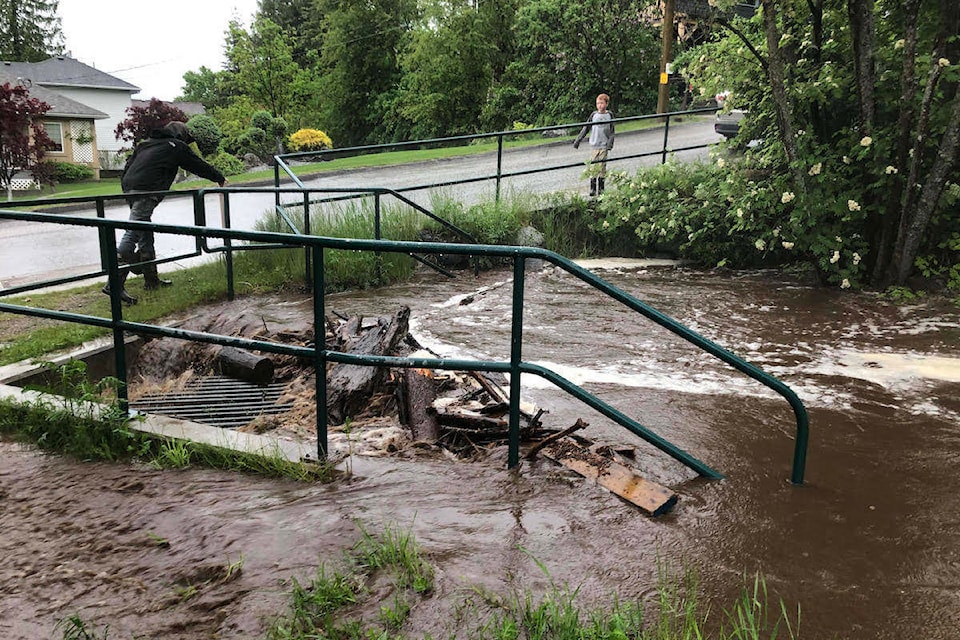Nelson City council decided at its Feb. 8 meeting to apply for a $9,320,739 grant to upgrade the city’s storm water system. The city will borrow another $2 million if the grant application is successful.
Climate change is causing changes in precipitation patterns, and storms are increasing in intensity, duration and frequency, Nelson’s public works director Colin Innes told council at an earlier meeting in October.
He said the city’s storm drain infrastructure was built for a different climate. He explained that Nelson’s current system consists of 866 catch basins, 23 outfalls to Kootenay Lake, and 32 outfalls to creeks.
The grant would come from a federal government green infrastructure program, which requires the city to provide a percentage of the project cost, in this case $2,285,841.
In 2018 the city hired the consultant SNC Lavelin to assess the city’s stormwater infrastructure. The company came back with a report and recommendations, including a $19-million estimate of cost of the recommended upgrades.
One of the measures the report uses is the number of catch basins that “surcharge” in a storm, meaning they are at full capacity. Currently in a high intensity short duration storm in Nelson (a storm that has a 10 per cent chance of occurring at any time) about 11 per cent of catch basins will surcharge.
The report predicts that in upcoming decades, even if the world does a reasonable job of reducing its greenhouse gas emissions, the rate of surcharge and overflow could more than double, causing significant flooding, as the number of such storms also increases.
The SNC report identified 180 underground locations in Nelson in which pipes need upgrading, mostly through installing larger pipes, changing outlet elevations, changing the grade of some pipes, or increasing the depth of some pipes.
Innes explained that there are two approaches to increasing threat of storm water: build bigger pipes so the water can be diverted from town in greater volumes, or design buildings and landscapes in such a way that they retain or absorb water.
Such methods include rooftop storage or parking lot storage, where specific roofs and parking lots are designed to hold rainwater, not drain it, for the short duration of a storm.
He also described rear yard storage, which includes rock pits and rain barrels at residences and businesses, as well as green roofs, rain gardens, vegetated swales, public green spaces, and other methods designed to collect and hold water during a rainstorm and then gradually release it.
“The cheaper way to control this water,” Innes said, “is to hold it in a parking lot or a grassy area. Putting pipe in the ground is very expensive, whereas having an area on the surface that is able to hold the water is cheaper.”
Innes said sports playing fields can function as water retainers during storms.
He said that as a general rule, the stormwater flow level that existed before an urban development should be retained after development. Innes said many newer big box stores are built so the parking lot will flood before gradually releasing water onto the streets.
“We need to look at it holistically,” Innes said. “Can this be solved by another means, as opposed to just building a bigger pipe?”
Currently the city has one water retention requirement. Developers must connect new buildings to the storm sewer or, as an alternative because storm sewer pipes do not exist on all streets, construct a rock pit that will collect excess water and slowly drain it.
Councillor Keith Page asked if opportunities to use various innovative water retention methods have been mapped or identified in Nelson. Innes said they had not, but this could be part of the work paid for by the grant. He said if the grant is received it would not automatically lead to the installation of bigger pipes. but could be used partly on alternative methods.
bill.metcalfe@nelsonstar.com
Like us on Facebook and follow us on Twitter
